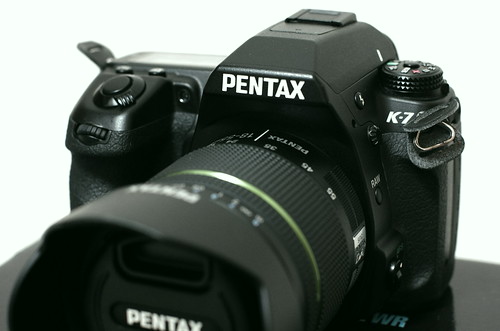Difference between revisions of "Pentax K-7"
Hanskerensky (talk | contribs) (→Links: <!--Commented out image, Author no longer on Flickr, please remove if not returned by 06/2018 -->) |
Hanskerensky (talk | contribs) (Repaired Link URL) |
||
| Line 10: | Line 10: | ||
The '''K-7''' succeeded the [[Pentax K20D|K20D]] in 2009 as the top [[DSLR]] model from [[Pentax]], using [[K-mount]] lenses. This model had a restyled, weather-sealed body, admired by those seeking "prosumer" features and build quality in a more compact package than most competitors' models. This also made a good match for Pentax's unusual DA series of compact, high-quality prime lenses, designed for use on APS-C sensor bodies. | The '''K-7''' succeeded the [[Pentax K20D|K20D]] in 2009 as the top [[DSLR]] model from [[Pentax]], using [[K-mount]] lenses. This model had a restyled, weather-sealed body, admired by those seeking "prosumer" features and build quality in a more compact package than most competitors' models. This also made a good match for Pentax's unusual DA series of compact, high-quality prime lenses, designed for use on APS-C sensor bodies. | ||
| − | The lone dark cloud hanging over the K-7 was its use of a 14-megapixel [[sensor]] manufactured by [[Samsung]]. While offering detailed images, this lagged competing sensors in high-ISO noise and dynamic range—most embarrassingly, it was outclassed by the [[Sony]] sensor used in [[Pentax K-x|Pentax's own K-x]], a camera whose price was hundreds of dollars lower. Accordingly, for the followup [[Pentax K-5]], Pentax switched to a different Sony sensor of measurably better performance<REF>[ | + | The lone dark cloud hanging over the K-7 was its use of a 14-megapixel [[sensor]] manufactured by [[Samsung]]. While offering detailed images, this lagged competing sensors in high-ISO noise and dynamic range—most embarrassingly, it was outclassed by the [[Sony]] sensor used in [[Pentax K-x|Pentax's own K-x]], a camera whose price was hundreds of dollars lower. Accordingly, for the followup [[Pentax K-5]], Pentax switched to a different Sony sensor of measurably better performance<REF>[https://www.dxomark.com/Cameras/Compare/Side-by-side/Pentax-K5-versus-Pentax-K7___676_615 Pentax K-7 and K-5 sensor raw performance] comparison at [http://dxomark.com/ DxO Mark]</REF>. Thus, the K-7 marked the end of the Pentax/Samsung collaboration, one that had produced several DSLR models from both brands (after this, Samsung struck out on its own with its [[Samsung#Mirrorless_system_cameras|mirrorless NX System]]). |
==Notes== | ==Notes== | ||
Revision as of 06:17, 23 November 2017

|
| image by nubobo (Image rights) |
The K-7 succeeded the K20D in 2009 as the top DSLR model from Pentax, using K-mount lenses. This model had a restyled, weather-sealed body, admired by those seeking "prosumer" features and build quality in a more compact package than most competitors' models. This also made a good match for Pentax's unusual DA series of compact, high-quality prime lenses, designed for use on APS-C sensor bodies.
The lone dark cloud hanging over the K-7 was its use of a 14-megapixel sensor manufactured by Samsung. While offering detailed images, this lagged competing sensors in high-ISO noise and dynamic range—most embarrassingly, it was outclassed by the Sony sensor used in Pentax's own K-x, a camera whose price was hundreds of dollars lower. Accordingly, for the followup Pentax K-5, Pentax switched to a different Sony sensor of measurably better performance[1]. Thus, the K-7 marked the end of the Pentax/Samsung collaboration, one that had produced several DSLR models from both brands (after this, Samsung struck out on its own with its mirrorless NX System).
Notes
- ↑ Pentax K-7 and K-5 sensor raw performance comparison at DxO Mark
Links
- Pentax K-7 review from DPReview.com
- User review by Gordon Lewis, at The Online Photographer